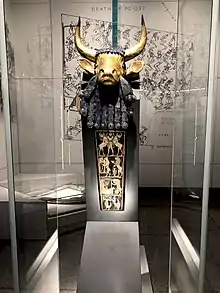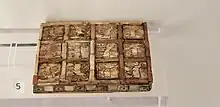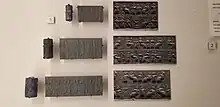Anne Draffkorn Kilmer | |
|---|---|
| Born | 1931 |
| Died | 2023 (aged 92) |
| Occupation | Professor of Assyriology |
| Awards | Guggenheim Fellowship (1961, 1962) |
| Academic background | |
| Alma mater | University of Pennsylvania (Ph.D.) |
| Thesis | Hurrians and Hurrian at Alalakh: An Ethnolinguistic Analysis (1959) |
| Doctoral advisor | Ephraim Avigdor Speiser |
| Academic work | |
| Discipline | Scholar of Ancient Mesopotamia |
| Sub-discipline | Ancient Music, games, mathematics, and Sumero-Akkadian cuneiform texts |
| Institutions | University of California, Berkeley |


Anne Draffkorn Kilmer (1931 – 2023) was an American historian of the ancient Near East who served as a professor of Assyriology at the University of California, Berkeley.[1] She was an expert in ancient Mesopotamian culture, specifically Sumero-Akkadian cuneiform texts and the history of ancient music, games, and mathematics.[2][3] In 1963, she became the first woman appointed to a tenure-track position in what is now the Middle Eastern Languages and Cultures department at the University of California, Berkeley.[4] She later became curator of the Babylonian collection in the Phoebe A. Hearst Museum of Anthropology, formerly the Lowie Museum. She rose to the rank of Professor, served as chair of her department three times, and acted as dean of humanities.[3]
Education, career, and scholarship
Kilmer earned her PhD at the University of Pennsylvania in 1959 for her dissertation entitled, “Hurrians and Hurrian at Alalakh: An Ethnolinguistic Analysis,” which she wrote under the supervision of Assyriologist Ephraim Avigdor Speiser, who discovered and excavated the site of Tepe Gawra.[5] After completing her PhD, she held a research fellowship from the American Association of University Women and worked as a research assistant for Benno Landsberger at the Oriental Institute of the University of Chicago. In 1963 she took a position as a visiting lecturer in Assyriology at the University of California, Berkeley. She went on to secure a tenure-track job at Berkeley and spent the rest of her career there, until she retired in 2001. She chaired the department of Near Eastern Languages three separate times – first in the 1970s, and twice in the 1990s.[6]

Anne Draffkorn Kilmer made many of her most important contributions to fields that she called “music archaeology” and “Mesopotamian music theory.” Kilmer is credited with deciphering the oldest known recorded piece of music, a 3,400 year old hymn from the Syrian city of Ugarit. This hymn addressed the moon goddess and asked for fertility and easy childbirth.[7] She also published scholarship on ancient Mesopotamian mathematics and entertainment, with the latter developing from her musical expertise.
References
- ↑ "Anne Draffkorn Kilmer (1931-2023)". melc.berkeley.edu. University of California, Berkeley. Retrieved 6 November 2023.
- ↑ Gale (2002). Directory of American Scholars (10th ed.). Detroit: Gale. ISBN 0-7876-7692-6.
- 1 2 Wolfgang Heimpel, Gabriella Szabo (2011). Strings and Threads: A Celebration of the Life of Anne Draffkorn Kilmer. Winona Lake, IN: Eisenbrauns. p. VII. ISBN 9781575062273.
- ↑ "Anne Draffkorn Kilmer (1931-2023)". melc.berkeley.edu. University of California, Berkeley. Retrieved 6 November 2023.
- ↑ Draffkorn, Anne Elizabeth (1959). Hurrians and Hurrian at Alalah : an ethno-linguistic analysis. University of Pennsylvania, PhD dissertation.
- ↑ "Anne Draffkorn Kilmer (1931-2023) | Middle Eastern Languages and Cultures". melc.berkeley.edu. Retrieved 2023-11-13.
- ↑ Interview with Anne Kilmer: The Hurrian Cult Song and Life in Ancient Times, retrieved 2023-11-13